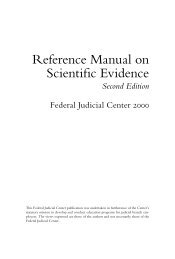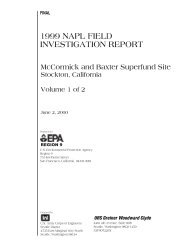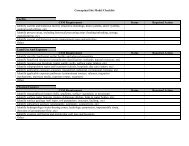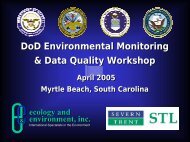Source Zone Delineation Demonstration Report - Triad Resource ...
Source Zone Delineation Demonstration Report - Triad Resource ...
Source Zone Delineation Demonstration Report - Triad Resource ...
Create successful ePaper yourself
Turn your PDF publications into a flip-book with our unique Google optimized e-Paper software.
The equilibrium four-phase distribution of each compound in the mixture is solved in VENT3D betweentime steps, facilitating the explicit solution of the time-variable retardation of the various compounds.The compounds are moved by one of three explicit transport algorithms. In high velocity environments, athird-order, Courant-number-weighted algorithm can be used for higher accuracy. In dispersivedominatedenvironments, a combination of upwind and central-weighted algorithms can be used. Themovement of soil moisture is also simulated, and permeability is time and grid variable as a function offluid (contaminant and water) saturation. Effective molecular diffusion is calculated by the Millingtonand Quirk correlation. The model also can be used to simulate the movement of compound mixtures bydiffusion only, for use in fate-and-transport studies.The simulation grid used for the preliminary SVE modeling was 740 feet long (x-direction), 500 feet wide(y-direction), and 80 feet deep (z-direction). The grid block spacing was constant in all directions withspacings of 20 feet in both the x-direction and y-direction and 10 feet in the z-direction. The x-directioncontained 25 grid-blocks, the y-direction contained 37 grid-blocks, and the z-direction contained 8 gridblocks.An average permeability of 1 Darcy (estimated from slug test conducted at OU 5) was assumedin the horizontal direction based on an average OU 12 hydraulic conductivity of 5 feet/day. The averagevertical permeability was assumed to be 10% the value of the horizontal permeability. The averagefractional organic carbon content of the soil was assumed to be 0.001 with an average water saturation of10%. The top and side layers of the simulation grid were assumed open to both air and chemicalmovement; the bottom layer was assumed closed (i.e., zero-flux boundary). One extraction well waslocated in the middle of the areal extent of the simulation grid and screened from 40 to 50 feet bgs. Ahomogeneous source containing 10,000 mg/kg TCE (corresponding to a residual NAPL saturation of1.3%) was placed at the same depth and at varying distances from the extraction well. Two differentsource configurations were investigated: (1) a 20-foot by 40-foot source contained in the homogeneouspermeability field, and (2) a 20-foot by 40-foot source trapped in a low permeability layer (0.1 Darcy)located in the higher permeability of the simulation grid. Two stress periods were simulated. The firststress period consisted of 30 years of no-flow at the extraction well to simulate the natural transport ofTCE in the vapor phase via diffusion. Following the diffusive transport period, the extraction well wasused to simulate soil vapor extraction under various flow regimes.The predicted distribution of TCE in soil vapor following a 30-year period of diffusive transport in ahomogeneous permeability field of 1 Darcy is shown in Figure 4-2. The simulated source zone wasapproximately 8,000 ft 3 and contained a residual NAPL saturation of 1.3%. Under these conditions, theequilibrium soil-vapor concentration of TCE in the source zone was estimated as approximately 540mg/L. As is evident from Figure 4-2, the diffusive transport of TCE in the vapor phase away from thesource zone in a fine-grained sediment similar to that in the OU 12 vadose zone is a slow process. After30 years, TCE concentrations in the soil vapor were less than 1 mg/L at a distance of approximately 100feet from the source. However, it is important to note the simulations did not consider vapor transportprocesses occurring in the subsurface due to changes in weather-related events (i.e., barometric pumping).Barometric pressure changes can result in significant viscous flow that can exceed the contribution toflow generated through diffusive flux.March 2003 4-3 OU 12 <strong>Demonstration</strong> <strong>Report</strong>Final










